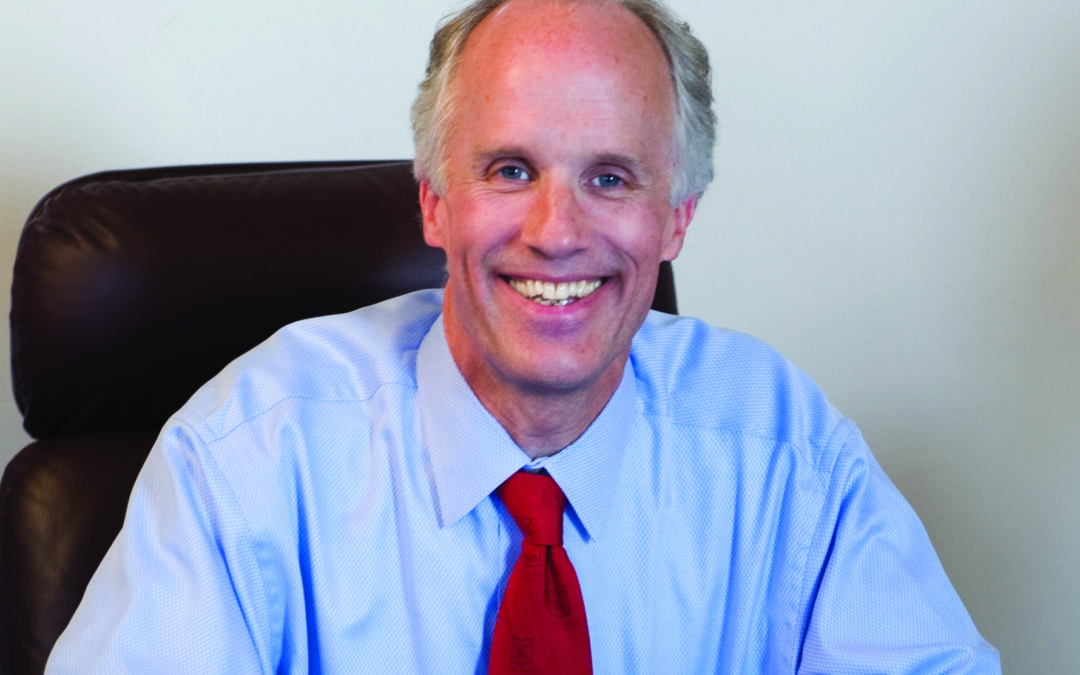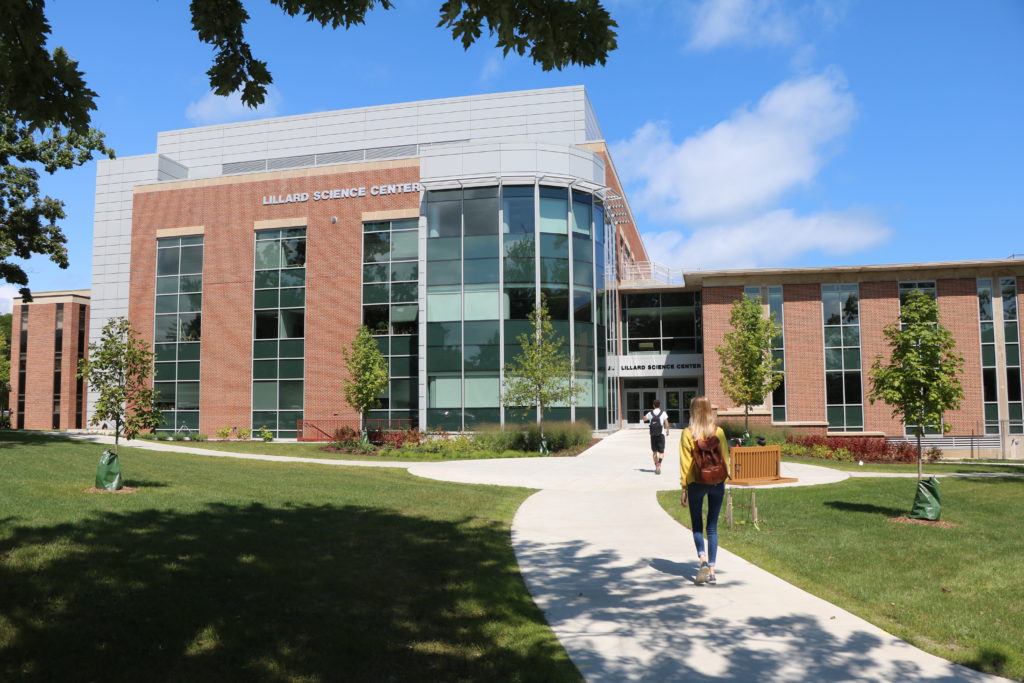Q&A WITH STEPHEN SCHUTT
President of Lake Forest College
In this issue of Catalyst, we sit down with Lake Forest College President Stephen Schutt. Lake Forest College is one of ISTC’s newest members and a place of growing excellence in research, science education, and entrepreneurship. It’s not unusual for students at the four-year liberal arts school to get involved in award-winning research at the undergraduate level, which propels them into dynamic careers and further education.
Tell us about the science program at Lake Forest College and what the new Lillard Science Center offers?
The sciences at Lake Forest College are diverse, hands-on, and collaborative. Our size allows us to provide our students with hands-on research experience as early as their first year, and the opportunity to work one-on-one with faculty. Our faculty are conducting research on critical issues—Parkinson’s disease, tuberculosis, memory, human genes, aging, slowing the speed of light, the environment, and much, much more. Their research is supported with grants from the National Science Foundation, the National Institutes of Health, the Parkinson’s Disease Foundation, the National Institute of Mental Health, the American Society for Biochemistry and Molecular Biology, and other agencies.
On a regular basis, our students work with equipment and instrumentation that you typically only find at the graduate-school level or in industry. Graduate schools regularly communicate with us about how impressed they are at the experience our students list on their resumes. To further increase our science equipment and instrumentation, we received last year a half-million-dollar grant from the Sherman Fairchild Foundation for our new Lillard Science Center.
The new Lillard Science Center will be an interdisciplinary hub because that’s the future of science. Biochemistry and molecular biology, biology, chemistry, environmental studies, neuroscience, physics, and psychology are all together under one roof covering the 130,000-square-foot facility. We also created an open environment—labs with large glass windows so everyone can see what’s going on inside, and multiple small-group work areas throughout the building—that has made it even easier for our faculty and students to collaborate on research, which is highly valued at Lake Forest College.
What kind of research opportunities do you provide for your students?
Our science students spend a great deal of time in the lab. They work directly with faculty so they see early in their academic career how scientific research is conducted. First-year students in our Richter Scholar Summer Research Program spend their summer on campus conducting independent, individual research with our faculty. At the end of the program, they present their independent research at a well-attended public forum.
We also have a strong partnership with Rosalind Franklin University of Medicine and Science, where current students and recent graduates work in the labs of medical school professors. For the past 10 years, Lake Forest students have researched alongside graduate students, postdoctoral scientists, and health professionals through this program, gaining valuable experience, mentorship, and networking.
This year, the Institute for Tuberculosis Research in the College of Pharmacy at University of Illinois at Chicago began a five-year collaboration for our students to synthesize new potential pharmaceuticals in our labs that they will test for anti-TB biological activity.
Our students also submit their research to Eukaryon, our peer-reviewed, undergraduate research journal that publishes the very best of life science scholarship. Hundreds of students have been involved in this publication since it started with a National Science Foundation grant in 2004.
How has this research and publishing experience benefited your students?
Our students win grants, awards, and are listed as co-authors on published work. Just this past year, one of our students won a prestigious Barry Goldwater Scholarship for undergraduate excellence in the sciences, two students published a paper on their original research in the Yale Journal of Biology and Medicine, one student won a national grant to research Parkinson’s disease, and another landed a fellowship research position with the National Institutes of Health. Clearly, our science program is preparing future leaders.
Where do your students go after graduating from Lake Forest College?
Our unique career preparation model offers our students five distinctive Career Pathways, which are specialized communities headed by professional staff members. The Pathways include Science and Health Care, Business and Finance, Creative Arts, Law and Public Service, and Build Your Own. These Pathway communities guide students in exploring career options and matches them with career preparation opportunities, including networking events, internships, workshops, and job shadowing. Each Pathway also has a team of people supporting students and making connections and opportunities happen. The teams consist of alumni, trustees, employers, professors, fellow students, and friends of the College. (To learn more about connecting with Lake Forest College students, visit lakeforest.edu/employers.)
How do the liberal arts make a difference for your science students?
Many of our science students double major or minor in another subject. The second major or minor is often in the humanities or social sciences. Our most popular minor is our award-winning Entrepreneurship and Innovation Program. Students recognize it as a valuable benefit and addition to their studies, no matter what major or career they intend to pursue. Our program director was recently named Illinois Entrepreneurship Professor of the Year by Future Founders, and we also feature an Advisory Council of highly successful entrepreneurs and leaders, representing a diverse range of industry expertise. (To learn more about the program, visit lakeforest.edu/entrepreneurship.)
Our outcomes prove the value of our educational approach. In 2017, 98 percent of our graduates had jobs or were in graduate school within nine months of graduation.
ICYMI: ILLINOIS’ R&D INDEX & RESEARCHERS TO KNOW
Last week, we released our latest R&D Innovation Index and Inaugural “Researchers to Know”. Our latest Index sheds light on Illinois’ R&D ecosystem while highlighting Illinois’ leading researchers innovating across disciplines.

WHAT WE’RE READING:
- Allstate’s CEO wants to change the way people give companies their personal data [Fortune]
- Chicago unites to showcase venture ecosystem [Forbes]
- Illinois’ $700M VC fund wants to keep startups from fleeing to the coasts [Chicago Inno]
- Tech companies are choosing Chicago [US News & World Report]
- Grubhub buying campus food app for $150M [Crain’s Business Chicago]
- How Illinois universities are getting more students interested in STEM careers [Venture Beat]
- Here are the Chicago tech companies that raised money in September [Chicago Inno]
- Mapping tech company Here names Chicago its HQ for the Americas [The Star]
- Amy Francetic raises $150M venture capital fund [Crain’s Business Chicago]
- All top US VC firms will have Chicago offices in 5 years [Chicago Inno]


